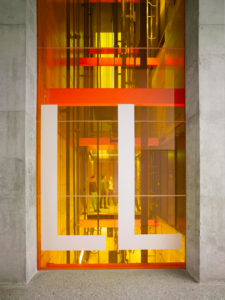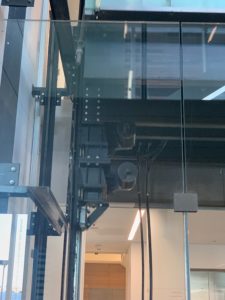GLASS ELEVATORS
The DTS Project House is about living on a hillside and the change of elevation this necessitates. Thus, a central elevator connecting the multiple floors of the hillside property was an integral design element from the first schematic design. As a central design element both visually and experientially the elevator must be more than a utilitarian way to get people and objects up and down. The design calls for more than the typical residential wood box with a swing door and accordion gate. The elevator was always envisioned as accentuating the spatial dynamics of moving up and down the site, so a glass cab and shaft providing both views from the cab and into the cab was an early design decision.
The DTS Project House elevator will be equally experienced from inside and outside, from in the cab and looking into the shaft. The aspects of the elevator affecting its experience include the inside and outside cab design, the inside and outside shaft design, the exposed structure at each floor level, the mechanical infrastructure exposed inside the shaft, and the views from the cab and through the shaft.
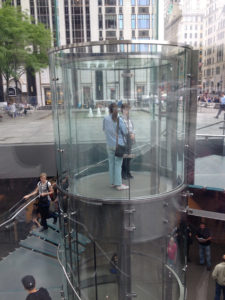

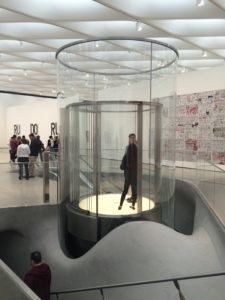
The desired design attributes called for an elevator that was more public and commercial than private and residential. mills studio visited numerous glass elevator installations in significant public buildings documenting approaches to cab and shaft design and experiencing strategies for integrating elevators into a building’s architectural experience, and in some cases elevators made into art pieces. Particular attention was paid to differing approaches toward exposing the elevator infrastructure since a glass shaft enclosure will allow views of any exposed infrastructure that makes the elevator function. mills studio documented varied glass shaft enclosures from minimal to articulated to enclosed.
Elevator Shaft
The elevator shaft design is driven by the fact that we want views out from the elevator cab. This necessitates a substantially glass enclosed shaft which means more often than not the experience of the elevator will be the visual experience of looking into the empty vertical shaft. Thus, decisions must be made as to which faces of the shaft are transparent and opaque and how this frames views both into and out of the shaft and how reflections make the glass more and less transparent.
The visual experience begins with the structure that separates the shaft from the house and extends to the finishing of the shaft interior. An articulated enclosure structure becomes a focal point to be looked at with a more minimal shaft enclosure highlighting the shaft interior and the views through the shaft. The structure holding the shaft enclosure will be seen from both inside the cab and outside the cab. Thus, the structure has both an exterior and interior of equal importance. The detailing of both sides of the enclosure structure must be considered.

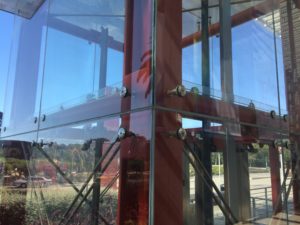
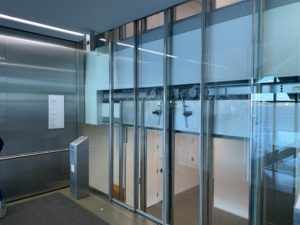
Elevator Cab
The elevator cab’s impact is as much about its exterior as its’ interior. The transparent glass shaft highlights the cab’s exterior, so the “exterior” finishes are seen as often as the cab’s interior finishes and the top and bottom of the cab is as visually important as any of the cab sides. The choice of materials, including the finish, the color, the sheen, the reflectivity, impacts the cab’s experience both from within and from without. The glass shaft enclosure means all twelve cab surfaces must be considered. The combination of the glass shaft and glass cab sides also means riders of the elevator are on display. How the functional controls, including phone, are integrated inside and outside the cab impact both the functional and visual experience of the elevator.

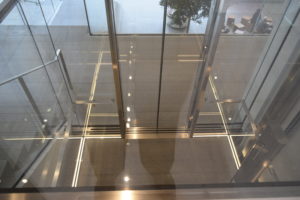
Mechanical Infrastructure
The mechanical infrastructure that propels the cab up and down will necessarily have certain aspects exposed and other aspects can be exposed by choice. Thus, the mechanical infrastructure will and can be a part of the visual experience of the elevator shaft both from the elevator cab and from the spaces adjacent to the shaft. Infrastructure on the walls, floor and ceiling of the shaft and on the bottom and top of the cab, as well as the infrastructure that must move with the elevator must all be considered for how they affect the elevator’s visual experience.
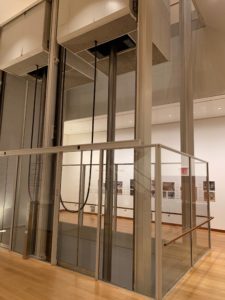
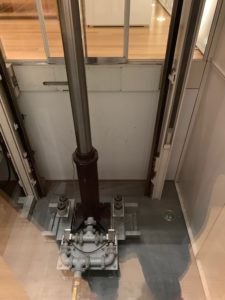
Lighting
Lighting of the shaft interior and the adjacent spaces will greatly affect the experience of thee shaft at night. The lighting will determine the opaqueness or transparency of the glass shaft enclosure and how one does or does not see through the shaft to the framed views. The shaft has the opportunity to act as light fixture providing ambient light to the surrounding spaces including the exterior or act as a black void. Lighting also has the opportunity to accentuate the shaft’s verticality and connectedness of the various levels or accentuate the various floor levels. Lighting can highlight either the top and / or bottom of the cab. Lighting can both be an artistic expression and / or be an integral part of the elevator as an integrated art piece.
Art Integration
The elevator shaft and the experience of moving up and down both have the opportunity to be part of an artistic expression. The shaft and cab surfaces can act as canvasses for artistic expressions directly on the surfaces or projected onto the surfaces. The shaft affords the opportunity to create an expression that is experienced as a whole from multiple levels and as individual aspects from specific floor levels. The cab top and bottom surfaces afford the opportunity to use horizontal surfaces as a canvass accentuating how changing eye levels and perspectives affect the experience of the surfaces. The fact that the shaft surfaces can be seen from inside the cab as the cab stands still and as the cab moves vertically also provides the opportunity to incorporate movement and changing eye levels into a visual experience. Sound, possibly coordinated with the elevator’s movement and visual experience, can also contribute to the artistic expression. An artistic expression can take into account or ignore people on display.


